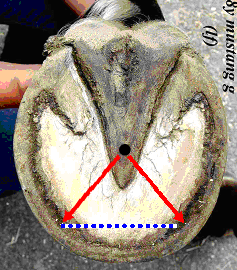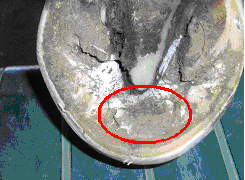| I am often asked about leaving horses barefoot. I must say from the onset that I favor horses being maintained without shoes when possible. Whether or not it is feasible for a horse to go with out shoes will depend on the owners’ situation /expectations and many variables that influence the feet. I also feel that horses can be shod in a physiologic manner such that the structures of the foot may change but very minimal damage to the hoof will occur. Shoes are used for protection when wear of the hoof exceeds growth, for traction which is often needed in the performance horse for athletic activities and for therapeutic reasons in order to treat disease or to address limb conformation. One or a combination of the above reasons may dictate the necessity for shoes. Much of the horse industry is involved in the athletic performance of horses and the question arises “can this horse compete and perform at its best without shoes?” As all horses are not created equal, neither are their feet. So when we decide whether a horse can be kept barefoot (and many can’t), many variables have to be considered. The breed of the horse, the hoof conformation, the manner in which the horse is kept, the surface on which it is worked and most important, for what purpose the horse is going to be used. It also makes a big difference if the horse has worn shoes previously and for how long, as well as the previous farrier care the the animal has received will all determine whether a horse will be a candidate to go without shoes. Many horses can do well without shoes as long as they are not asked to perform. Horses are much easier to maintain in a barefoot manner if they have never had shoes. The majority of horse’s feet remain healthy until the time they are broke and begin training. During this time a lot of changes to the feet take place. Once training begins usually as 2 year olds, the hoof capsule and its related structures are still immature, the animal is confined more, and it now has a rider placed on its back which leads to additional weight bearing on the feet. These factors usually lead to excessive wear on the feet and shoes are placed on the feet for protection. It has been discovered that the horse has receptors in the bottom of its foot and it is speculated that these receptors function in a stimulatory capacity. So the first thing that happens when shoes are applied is that these receptors loss contact with the ground. Next we look at the application of shoes by the farrier. How much protection is removed from the bottom of the foot in the form of hoof wall, sole depth and the bars? How is the shoe fitted and attached to the foot i.e. where are the nails placed, how many and what size. As training progresses, the horse generally receives more baths which increase the moisture in the feet over time and make them softer. So we see right off that the combination of the above factors can/will change the structures of the foot forever. Prove this to yourself by taking a digital photo of a horse’s foot at the start of training and then take another photo 6 months to a year later and compare the difference. Traditionally we place shoes on these youngsters too early and often it is not necessary as long as a few modifications are made in our training program. If you decide to remove the shoes and attempt to use your horse barefoot, we recommend a 30-90 day transition period during which time the horse is taken out of work. This allows the structures of the horse’s feet to toughen and adapt to being without shoes. At this point we also change the method of hoof care from trimming the foot to “shaping” the foot. Nothing is removed from the bottom of the foot. Using a rasp, the heels are moved back to the base of the frog (when possible) and the hoof wall is not lowered but just rasped on an angle so a rounded edge is created. Flares or excess toe are removed from the outer hoof wall (shaping). We finish by slightly beveling the toe as illustrated in the in Fig. 1 below to promote sole growth and to toughen the so called sole callus. See Fig 2. 
Fig. 1 The black dot is the widest part of the foot, the red arrows lead to the “pillars” and the blue dotted line is where the toe is beveled with a rasp. 
Fig. 2 Note the sole callus in this trimmed foot There are advocates of the barefoot movement that claim through their research that applying shoes to the horse is detrimental and therefore all horses need to be barefoot. This research claims that nails placed in a horse’s foot are toxic, that the bars in the heels should be removed as they impinge on the circulation and that all horses should be trimmed in a specified manner. Yet I have never been privy to this research. Briefly, I have never seen a scientific publication that states nails are toxic when placed in a horse’s foot. If we think of the hoof capsule as a cone – one quickly sees the necessity of preserving the bars as they provide stability and allow the hoof capsule to expand which in turn allows the normal physiology of the foot to take place. Finally, if we consider the various breeds of horses, individual foot conformation, structures of the foot, phalangeal alignment, etc, it would appear highly unreasonable to trim all horses in the same manner. |